Top 15 Most Beautiful Rhododendron Varieties to Transform Your Garden
Published: September 11, 2025 at 10:29:29 PM UTC
Rhododendrons are the royalty of flowering shrubs, bringing magnificent blooms and year-round structure to gardens of all sizes. With thousands of varieties available, these versatile plants offer something for every garden setting—from compact dwarf varieties perfect for containers to towering specimens that create dramatic focal points. In this guide, we'll explore 15 of the most beautiful rhododendron varieties that can transform your outdoor space into a breathtaking display of color and texture.
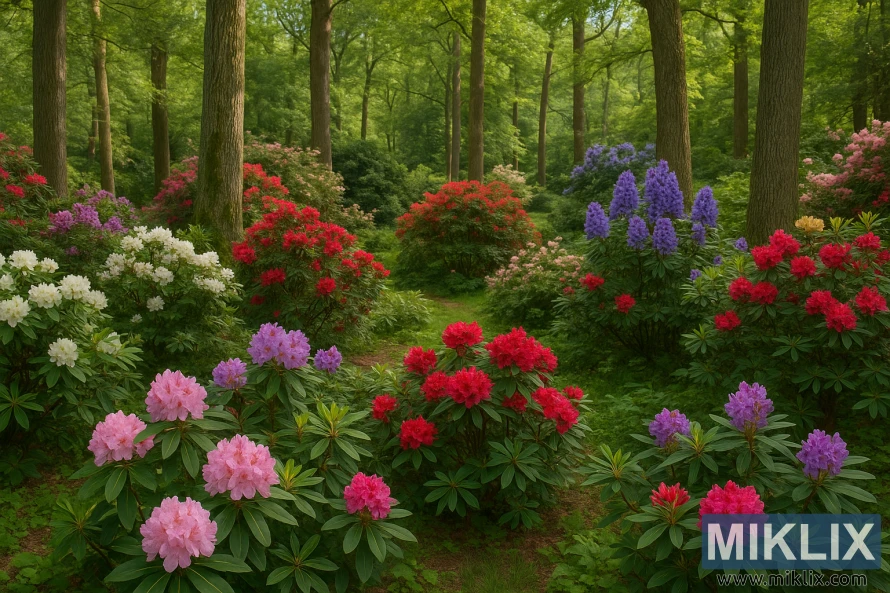
Understanding Rhododendrons: The Basics
Before diving into specific varieties, it's helpful to understand what makes rhododendrons such garden favorites. These flowering shrubs belong to the genus Rhododendron, which includes over 900 species and thousands of hybrids. They thrive in acidic soil (pH 4.5-6.0) and generally prefer dappled shade, though some varieties tolerate more sun.
Most rhododendrons grow best in USDA hardiness zones 4-8, though there are varieties suited to zones 3-9. They prefer consistent moisture but good drainage—their shallow root systems can't tolerate standing water. With proper care, these magnificent plants reward gardeners with spectacular blooms and, in many cases, attractive evergreen foliage year-round.
15 Most Beautiful Rhododendron Varieties for Your Garden
From compact dwarf varieties to magnificent specimens, these rhododendrons offer stunning blooms, interesting foliage, and reliable garden performance. Each has been selected for its exceptional beauty and garden-worthiness.
1. 'Nova Zembla'
Botanical name: Rhododendron 'Nova Zembla'
Bloom description: Vibrant red flowers with burgundy freckles bloom in mid-spring, creating a dramatic display against the glossy green foliage.
Growth habit: This vigorous grower reaches 6-8 feet tall and 5-7 feet wide at maturity.
Unique features: Exceptional cold hardiness (to -25°F), heat tolerance, and sun resistance make this one of the most versatile rhododendrons for challenging conditions.
Growing conditions: Thrives in partial sun to light shade in zones 4-9. More sun-tolerant than many rhododendrons but still appreciates afternoon shade in hot climates.
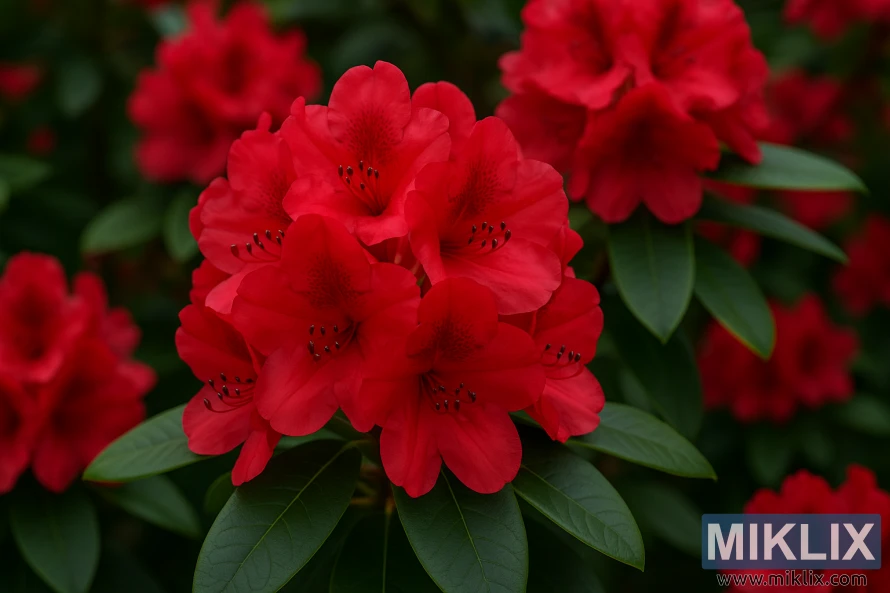
2. 'Blue Peter'
Botanical name: Rhododendron 'Blue Peter'
Bloom description: Lavender-blue flowers with deep purple centers create a striking bicolor effect. Each bloom reaches nearly 3 inches across, with clusters containing up to 15 flowers.
Growth habit: Compact and rounded, growing 3-4 feet tall and wide.
Unique features: True blue flowers are rare in the plant world, making this variety especially prized. The evergreen foliage maintains its deep green color year-round.
Growing conditions: Best in partial shade in zones 5-8. Prefers consistent moisture and protection from harsh afternoon sun.
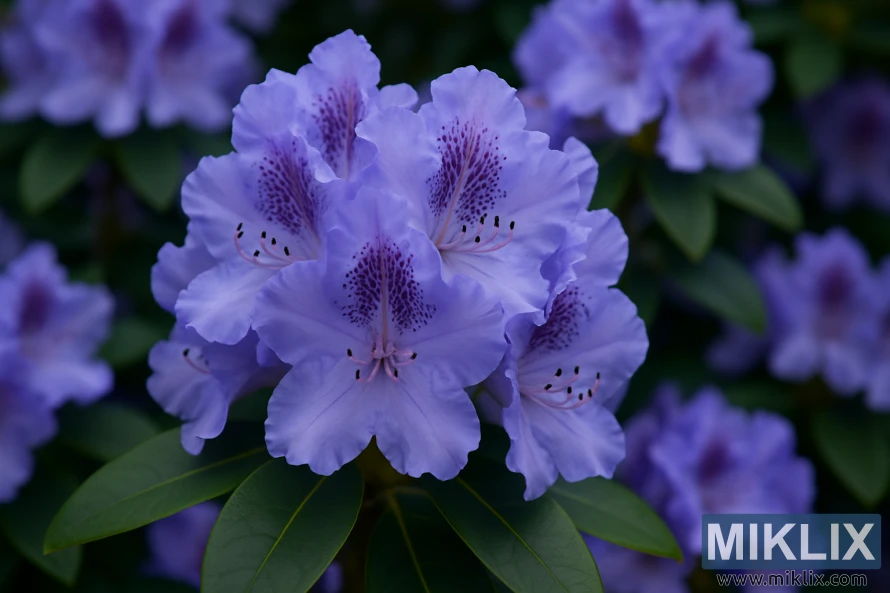
3. 'Scintillation'
Botanical name: Rhododendron 'Scintillation'
Bloom description: Light pink flowers with gold freckles bloom in mid-spring. Each flower reaches 2.5 inches across, with 11-15 flowers per truss.
Growth habit: Medium-sized shrub growing 4-6 feet tall and wide.
Unique features: Award-winning variety known for its exceptional flower display and cold hardiness. The evergreen foliage maintains good winter appearance.
Growing conditions: Thrives in partial shade in zones 5-8. Prefers rich, acidic soil with good drainage.
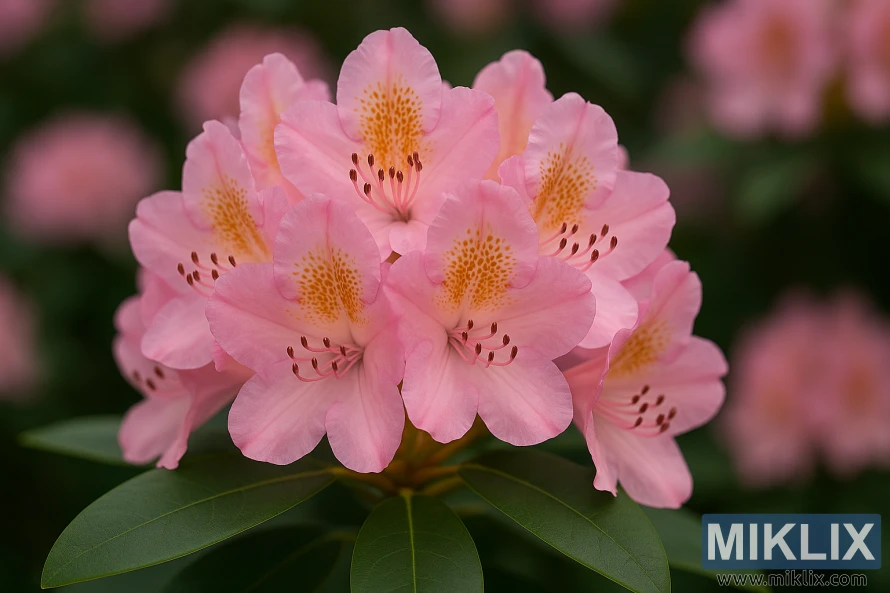
4. 'Dexter's Orange'
Botanical name: Rhododendron 'Dexter's Orange'
Bloom description: Unique apricot-orange flowers with pink splashes create a warm, glowing effect in the garden. Each truss contains about eight 3-inch flowers.
Growth habit: Compact shrub growing 3-4 feet tall and wide with a dense, sweeping habit.
Unique features: Part of the prestigious Dexter collection, this variety offers a rare color in rhododendrons. The olive-green foliage provides year-round interest.
Growing conditions: Best in partial shade in zones 5-8. Appreciates rich, acidic soil and protection from harsh afternoon sun.
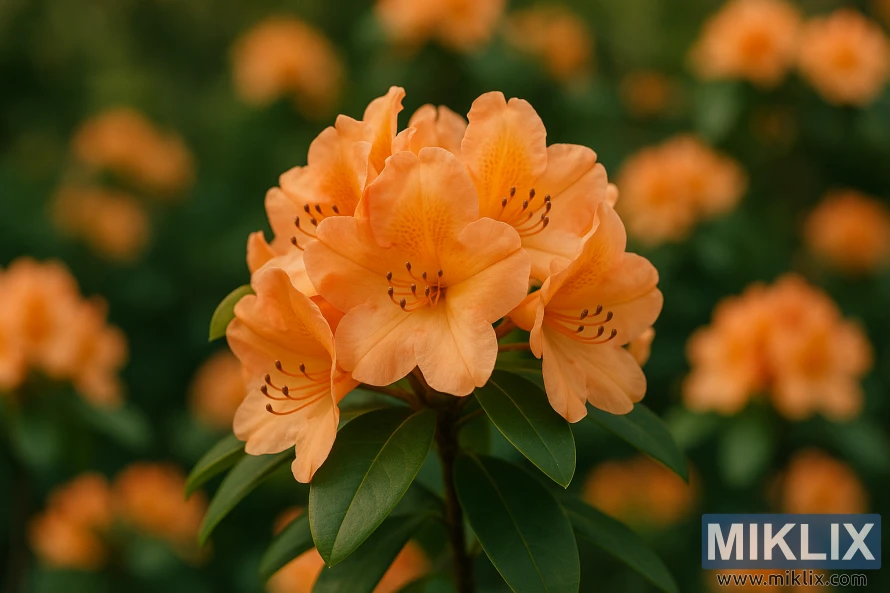
5. 'Boule de Neige'
Botanical name: Rhododendron 'Boule de Neige'
Bloom description: Crisp white flowers with light green freckles and elegantly wavy petal edges. Each bloom reaches nearly 3 inches across, with 10 flowers per truss.
Growth habit: Medium to large shrub growing 4-5 feet tall and wide, though it can reach up to 10 feet with age.
Unique features: Dating back to the late 1800s, this classic variety offers lightly scented flowers and exceptional cold hardiness. The soft green foliage has hints of gray.
Growing conditions: Thrives in partial shade in zones 4-8. Tolerates more cold than many rhododendrons.
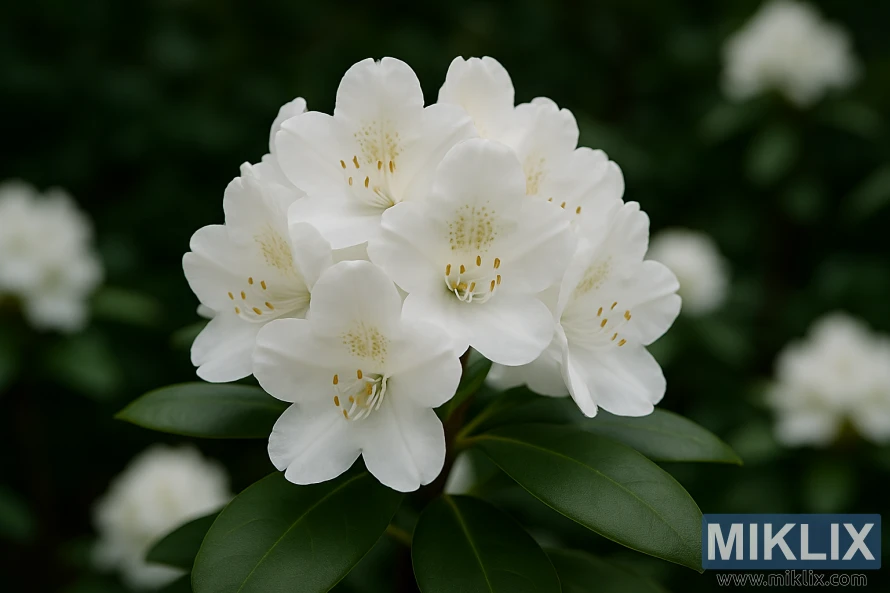
6. 'Cherry Cheesecake'
Botanical name: Rhododendron 'Cherry Cheesecake'
Bloom description: Striking bicolor flowers with white centers, bright pink edges, and deep burgundy splotches on the upper petals. The large, ball-shaped trusses create a spectacular display in late spring.
Growth habit: Medium-sized shrub growing 4-5 feet tall and wide.
Unique features: The dramatic color contrast makes this variety a true standout in the garden. Large, deep green leaves provide year-round structure.
Growing conditions: Best in partial shade in zones 5-8. Prefers rich, acidic soil with consistent moisture.
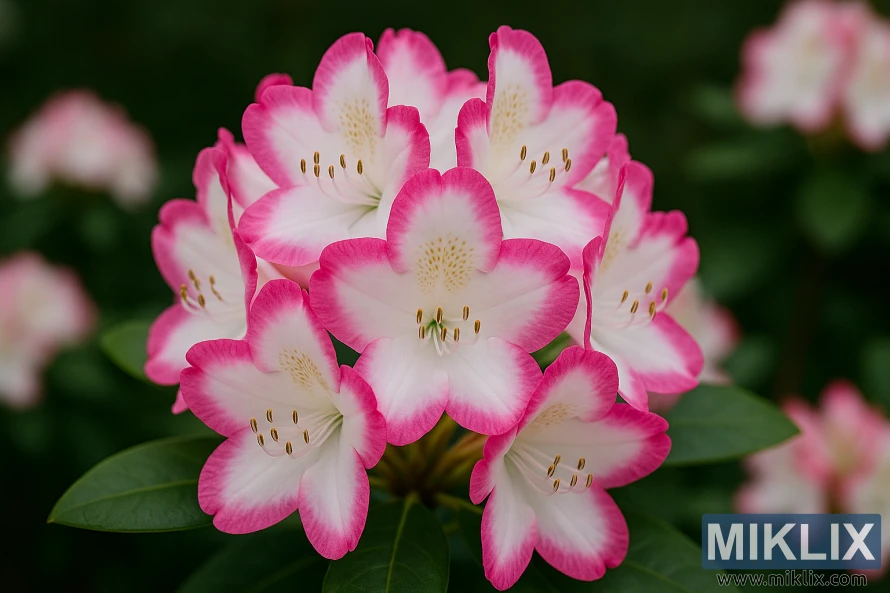
7. 'PJM Elite'
Botanical name: Rhododendron 'PJM Elite'
Bloom description: Vibrant purple flowers bloom in mid-spring, with 10-15 flowers per cluster. The bright color stands out dramatically in the spring garden.
Growth habit: Medium-sized shrub growing 5-6 feet tall and wide.
Unique features: Exceptional cold hardiness and reliable blooming make this a dependable choice for northern gardens. The glossy green foliage turns burgundy in fall for multi-season interest.
Growing conditions: More sun-tolerant than many rhododendrons, growing well in partial sun to light shade in zones 4-8.
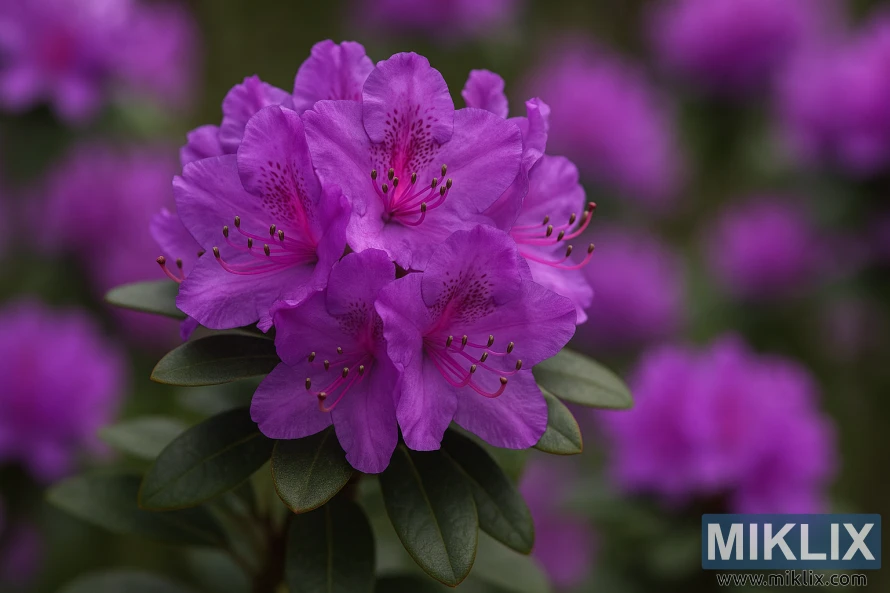
8. 'Wren'
Botanical name: Rhododendron 'Wren'
Bloom description: Bright yellow, cup-shaped flowers create a cheerful display in spring. The blooms are larger and more cup-shaped than many dwarf varieties.
Growth habit: Compact dwarf variety growing just 1-2 feet tall and 2-3 feet wide.
Unique features: Award-winning dwarf variety with excellent vigor despite its small size. Perfect for rock gardens, containers, or front of border plantings.
Growing conditions: Thrives in partial shade in zones 4-8. Works well in raised beds where good drainage can be ensured.
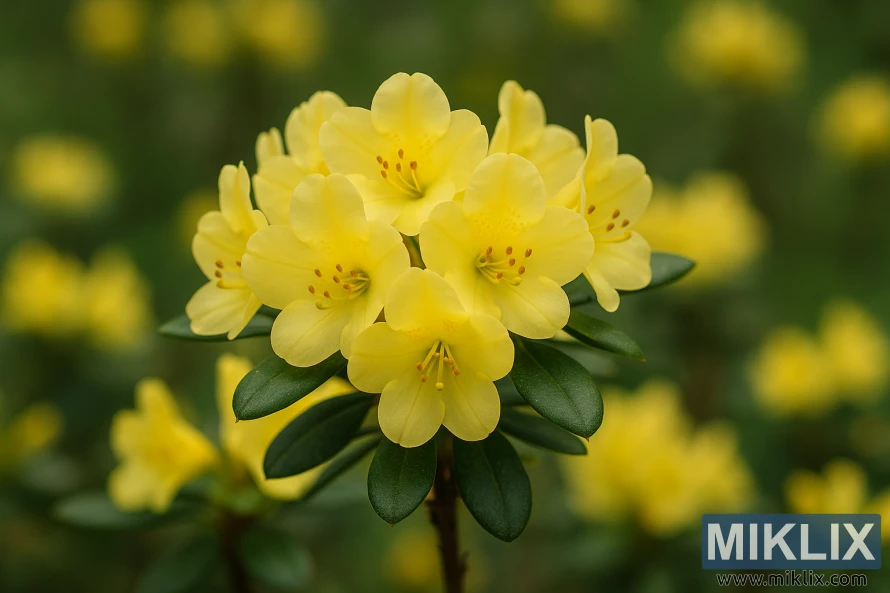
9. 'Ramapo'
Botanical name: Rhododendron 'Ramapo'
Bloom description: Pure purple flowers without the pink undertones common in many purple rhododendrons. The blooms appear in small, neat clusters in spring.
Growth habit: Very compact dwarf variety growing just 1-2 feet tall and 2-3 feet wide.
Unique features: Aromatic blue-green foliage that turns copper in fall provides multi-season interest. The compact size makes it perfect for small gardens.
Growing conditions: Adaptable to partial sun or light shade in zones 4-8. More tolerant of less-than-ideal conditions than many rhododendrons.
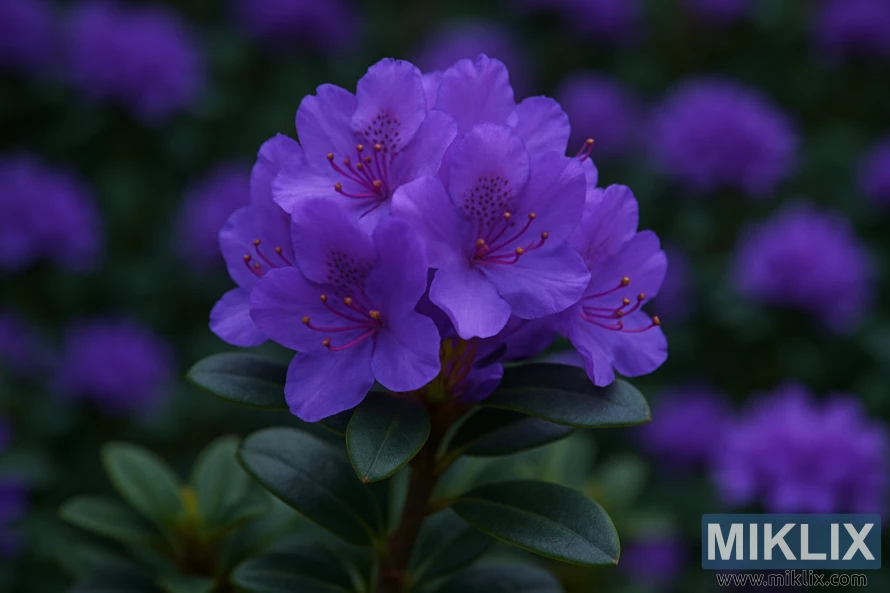
10. 'Ginny Gee'
Botanical name: Rhododendron 'Ginny Gee'
Bloom description: White flowers with bright pink accents create a bicolor effect with an almost tropical appearance. Each bloom reaches about 1 inch across, with 3-5 flowers per truss.
Growth habit: Very compact dwarf variety growing just 1-2 feet tall and wide.
Unique features: Perfect for small spaces, containers, or rock gardens. The semi-evergreen to evergreen foliage takes on reddish tones in fall.
Growing conditions: Best in partial shade in zones 6-8. Appreciates consistent moisture and protection from harsh afternoon sun.
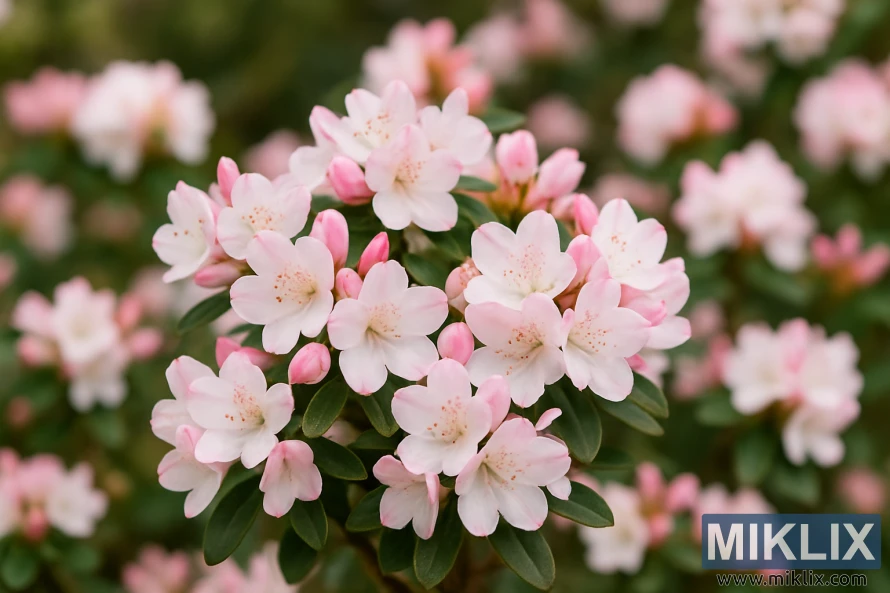
11. 'Roseum Elegans'
Botanical name: Rhododendron 'Roseum Elegans'
Bloom description: Pinkish-purple flowers with orange freckles bloom in mid to late spring. The flowers age to a more pink hue and appear in clusters of up to 10 blooms.
Growth habit: Large shrub growing 6-8 feet tall and wide.
Unique features: Exceptionally reliable and adaptable, this variety has been a garden favorite for generations. The olive-green foliage provides year-round structure.
Growing conditions: Versatile in partial sun to light shade in zones 4-8. More tolerant of less-than-ideal conditions than many rhododendrons.
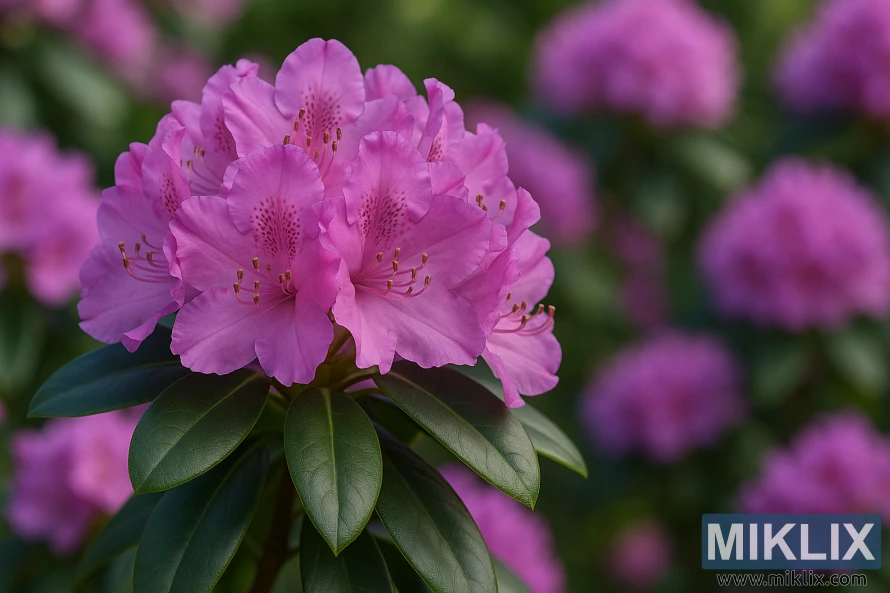
12. 'Loderi King George'
Botanical name: Rhododendron 'Loderi King George'
Bloom description: Large, fragrant white flowers with a hint of blush pink emerge from deep pink buds. Each truss contains 10-12 flowers, with individual blooms reaching 3 inches across.
Growth habit: Large shrub growing 4-8 feet tall and 6-8 feet wide.
Unique features: Intoxicating fragrance makes this variety especially prized. The stems and foliage take on burgundy tints in fall for added seasonal interest.
Growing conditions: Best in partial shade in zones 7-9. Prefers rich, acidic soil with consistent moisture.
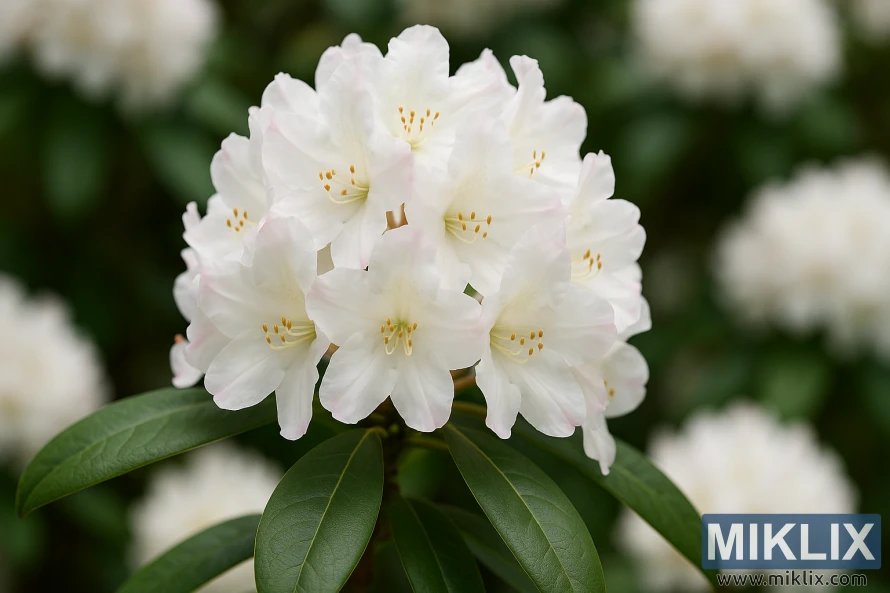
13. 'Gold Prinz'
Botanical name: Rhododendron 'Gold Prinz'
Bloom description: Light yellow flowers with red freckles create a cheerful display in late spring. The yellow blooms stand out dramatically against the dark foliage.
Growth habit: Medium to large shrub growing 5-7 feet tall and wide, often spreading wider than tall.
Unique features: Yellow-flowering rhododendrons are relatively uncommon, making this variety especially valuable. The glossy, deep green foliage provides an excellent backdrop for the blooms.
Growing conditions: Thrives in partial shade in zones 5-9. Works well as a hedge or under windows where the blooms can be appreciated up close.
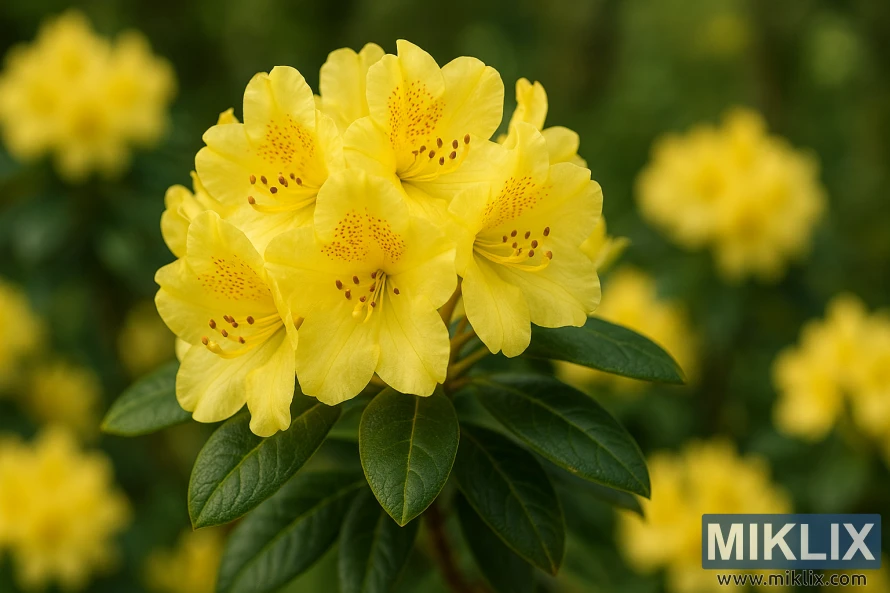
14. 'Ken Janeck'
Botanical name: Rhododendron 'Ken Janeck'
Bloom description: Pink flowers emerge from deep pink buds in mid-spring, gradually fading to white with greenish-brown freckles. The tightly packed trusses contain 13-17 flowers for a spectacular display.
Growth habit: Compact shrub growing 3-4 feet tall and 3-5 feet wide.
Unique features: The color transition from pink to white creates extended visual interest. The deep green, glossy foliage provides an excellent backdrop for the flowers.
Growing conditions: Best in partial shade in zones 5-8. Prefers rich, acidic soil with consistent moisture.
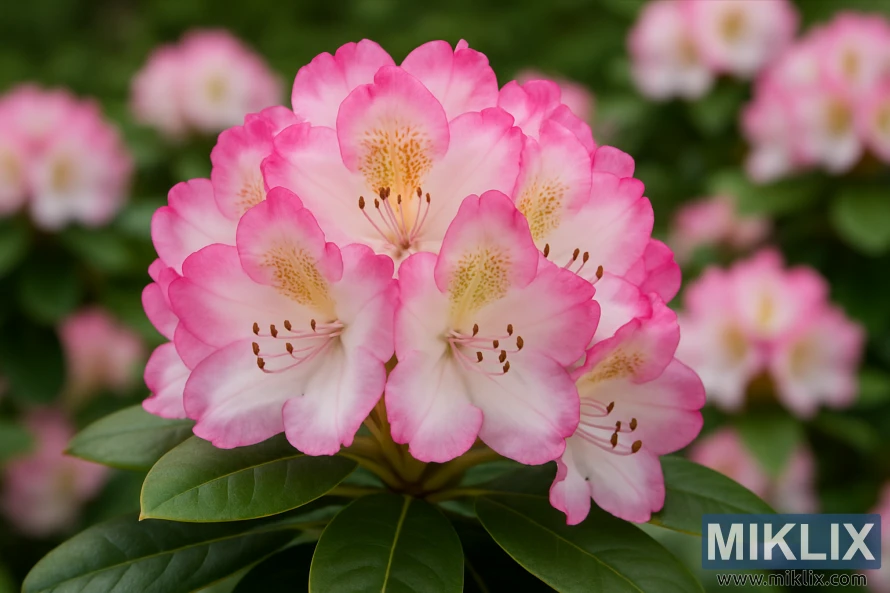
15. 'September Song'
Botanical name: Rhododendron 'September Song'
Bloom description: Unique bicolor flowers with light orange centers and bright pink ruffled edges create a spectacular display in spring. The loosely bunched trusses give the appearance of the shrub being covered in blooms.
Growth habit: Medium-sized shrub growing 4-5 feet tall and 5-6 feet wide.
Unique features: The unusual orange and pink color combination is rare among rhododendrons. The deep green, glossy evergreen foliage provides year-round structure.
Growing conditions: Thrives in partial shade in zones 6-8. More tolerant of dry conditions than many rhododendrons and grows well in fairly deep shade.
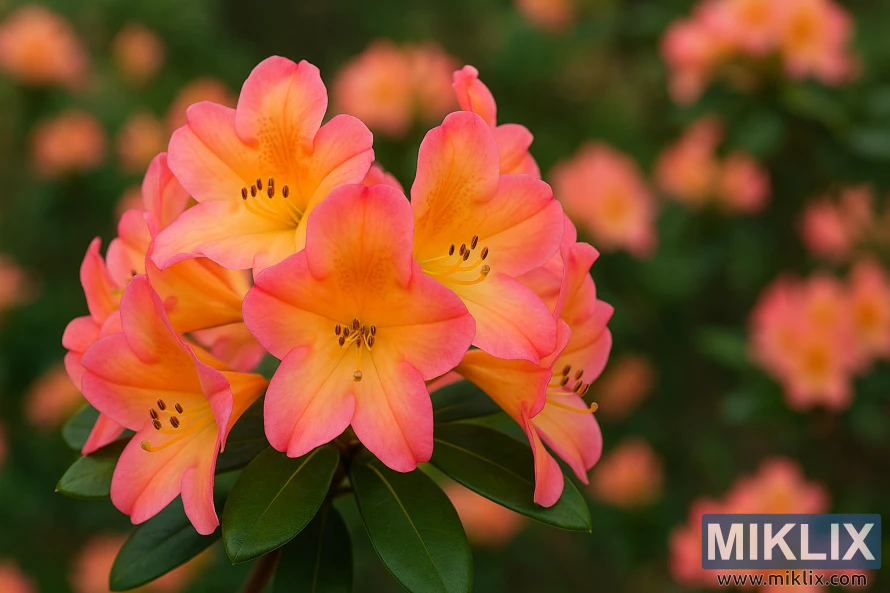
Companion Plants for Beautiful Rhododendron Varieties
Creating a harmonious garden design with rhododendrons involves selecting complementary plants that share similar growing requirements while providing contrasting textures and extended seasonal interest. Consider these excellent companions for your rhododendron garden:
Shade-Loving Perennials
- Hostas - Their bold foliage contrasts beautifully with rhododendron leaves
- Astilbes - Feathery flowers add texture when rhododendrons aren't blooming
- Ferns - Delicate fronds create a woodland feel that rhododendrons love
- Bleeding Hearts - Early spring blooms complement rhododendron flowering time
Woody Companions
- Japanese Maples - Provide dappled shade and spectacular fall color
- Mountain Laurel - Similar growing requirements with different bloom time
- Pieris japonica - Evergreen structure with early spring flowers
- Hydrangeas - Late summer blooms extend the flowering season
Bulbs and Ground Covers
- Spring Bulbs - Plant beneath rhododendrons for early color
- Epimediums - Drought-tolerant once established, with delicate flowers
- Tiarella - Frothy flowers and interesting foliage for ground cover
- Sweet Woodruff - Fragrant white flowers and spreading habit
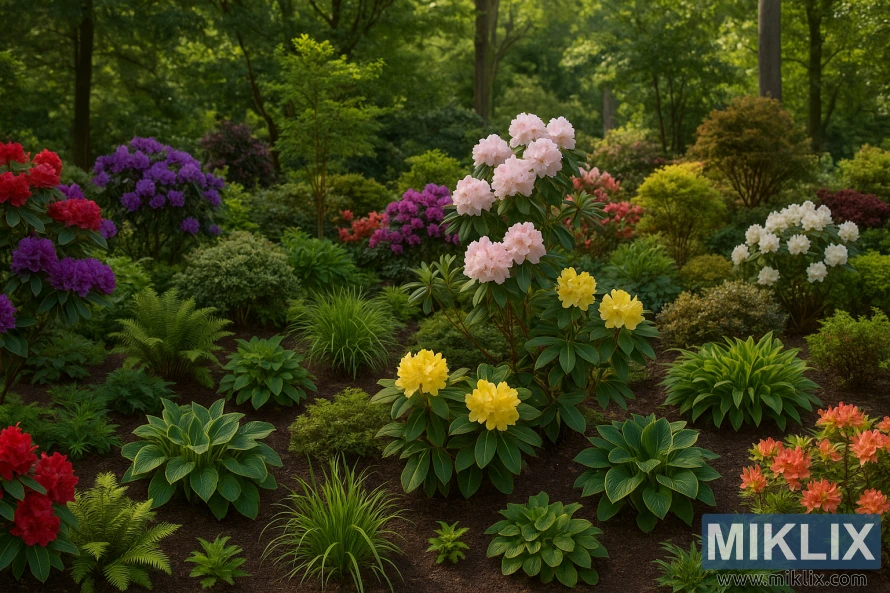
Essential Care Tips for Beautiful Rhododendron Varieties
Planting for Success
Proper planting is crucial for rhododendron health. Choose a location with dappled shade or morning sun and afternoon shade. Dig a hole twice as wide as the root ball but no deeper. The top of the root ball should sit slightly above soil level to ensure good drainage.
Amend the soil with organic matter like compost or pine bark. After planting, apply a 2-3 inch layer of mulch (pine needles, shredded leaves, or pine bark) to retain moisture and suppress weeds, but keep it away from the trunk to prevent rot.
Watering Wisdom
Rhododendrons need consistent moisture but hate wet feet. Water deeply once a week during dry periods, more frequently for newly planted shrubs. Established plants (3+ years) are more drought-tolerant but still benefit from regular watering during extended dry spells.
Feeding Schedule
Feed rhododendrons sparingly with an acid-forming fertilizer specifically formulated for rhododendrons and azaleas. Apply in early spring as buds begin to swell. Avoid fertilizing after mid-summer, as this can stimulate late growth that won't harden off before winter.
Pruning Practices
Most rhododendrons require minimal pruning. Remove dead or damaged branches anytime. If shaping is needed, prune immediately after flowering to avoid removing next year's flower buds. For rejuvenation, cut back one-third of the oldest stems to the ground each year for three years.
Pest and Disease Prevention
Healthy rhododendrons resist most problems. Watch for lace bugs, borers, and weevils. Prevent root rot by ensuring good drainage. Powdery mildew can be minimized with proper air circulation. Yellow leaves often indicate chlorosis from alkaline soil—apply sulfur or iron supplements as needed.
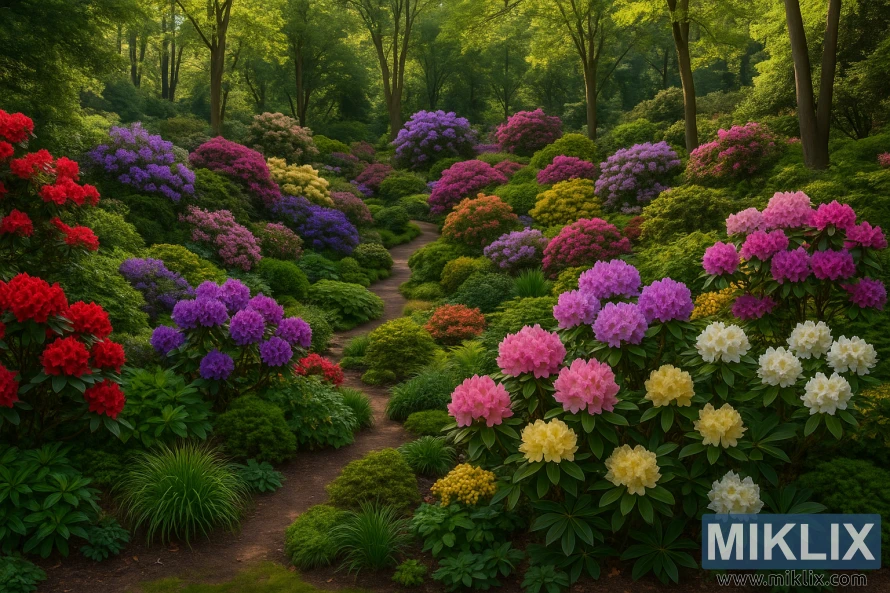
Seasonal Care Calendar for Beautiful Rhododendron Varieties
| Season | Key Tasks | What to Watch For |
| Spring | Apply fertilizer as buds swell; water during dry spells; enjoy blooms; prune after flowering if needed | Frost damage on early bloomers; lace bug activity; powdery mildew in humid conditions |
| Summer | Water deeply during dry periods; maintain mulch layer; remove spent flowers if desired | Heat stress; chlorosis (yellowing leaves); spider mites in hot, dry conditions |
| Fall | Stop fertilizing; continue watering until ground freezes; apply fresh mulch | Early frosts; leaf scorch from dry winds; fungal issues in wet conditions |
| Winter | Protect from drying winds; brush off heavy snow; apply anti-desiccant spray in harsh climates | Winter burn; deer browsing; branch breakage from snow/ice load |
Troubleshooting Common Issues with Rhododendrons
Why aren't my rhododendrons flowering?
Several factors can prevent blooming: insufficient light (most need some sun to flower well), improper pruning (removing flower buds), too much nitrogen fertilizer (promoting foliage at the expense of flowers), or late spring frosts killing flower buds. Ensure your plant gets morning sun, prune only after flowering, use a balanced fertilizer, and protect early bloomers from frost.
Why are my rhododendron leaves turning yellow?
Yellowing leaves (chlorosis) typically indicates iron deficiency due to alkaline soil. Rhododendrons need acidic soil (pH 4.5-6.0) to access iron. Apply sulfur to lower soil pH and use an iron supplement for quick results. Other causes include overwatering, poor drainage, or normal seasonal leaf drop (older inner leaves in fall).
What causes brown leaf edges on rhododendrons?
Brown leaf margins usually indicate drought stress or winter desiccation. Ensure consistent moisture, especially for newly planted shrubs. In winter, apply anti-desiccant spray and provide windbreaks for protection. Salt damage from road salt or fertilizer burn can also cause leaf browning—avoid both near rhododendrons.
How do I protect rhododendrons in cold climates?
Choose cold-hardy varieties for your zone. Create windbreaks with burlap screens or plant on the east side of buildings to avoid harsh western exposure. Apply 3-4 inches of mulch to insulate roots, but don't pile it against stems. Water thoroughly before the ground freezes. Apply anti-desiccant spray to foliage in late fall and again in mid-winter during a thaw.
Conclusion
With their magnificent blooms, interesting foliage, and year-round presence, rhododendrons offer unmatched beauty and versatility in the garden. Whether you choose the vibrant reds of 'Nova Zembla,' the delicate yellows of 'Wren,' or the unique bicolors of 'Cherry Cheesecake,' these spectacular flowering shrubs can transform ordinary landscapes into extraordinary garden retreats.
By selecting varieties suited to your growing conditions and following the care guidelines outlined in this guide, you'll enjoy years of spectacular blooms and healthy growth from these garden aristocrats. From compact dwarf varieties perfect for small spaces to magnificent specimens that create dramatic focal points, there's a beautiful rhododendron variety for every garden setting.
Further Reading
If you enjoyed this post, you may also like these suggestions:
- A Guide to the Most Beautiful Zinnia Varieties to Grow in Your Garden
- A Guide to the Most Beautiful Varieties of Bleeding Heart to Grow in Your Garden
- A Guide to the Most Beautiful Tulip Varieties for Your Garden
